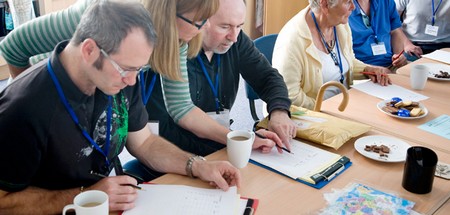We’ve got a mother-daughter team here. They wrote a book together, write an advice column for the Girl Scouts Web site together, and now will show you how you can get out and volunteer together. (Well wait, you don’t have to volunteer with your mom, but at least go out and volunteer.) They are Harriet S. Mosatche, Ph.D., and Elizabeth (Liz) K. Lawner:
Step l: Find out what’s needed in your community
HARRIET: The first step is a critical one. There’s no point doing something when the need doesn’t exist. And since every community can use help somewhere, do your volunteering where it will serve a real purpose. How do you gather this information?
Read your local newspapers-they often include information about volunteer opportunities. Talk to your parents and your friends’ parents-perhaps they’ve heard about an agency or organization that could use some help. News stories on radio and television offer other possibilities when you’re gathering information. Maybe an animal shelter in town is being overrun with strays after the holidays. Perhaps a new senior citizen facility would welcome young people as volunteers. Those are the kinds of stories that could present you with just the volunteer experience you’re looking for.
LIZ: Sometimes ideas for volunteer opportunities just come up. For example, with my Girl Scout troop, I entertained residents at a nursing home on Valentine’s Day for four years because my grandfather happened to live there, and I knew that without us they wouldn’t be doing anything special on that holiday.
Step 2: Decide what issue you’d like to tackle in your volunteer work
HARRIET: If you’ve done your homework, you’ve learned about a variety of different problems in your community. Choose one on which to take action. If you have a hard time making that decision, ask yourself some questions: Would you like to work with older people, young kids, or animals? What one topic interests you more than any other? (Is it literacy, child care, disabilities, abandoned animals, housing shortage, substance abuse?)
LIZ: I’m really interested in working with littie kids, so I volunteered along with some of my friends to teach sports skills to 5- and 6-year-old Daisy Girl Scouts. I also babysit, but I get paid for that most of the time.
Step 3: Decide how much time you have for volunteering
HARRIET: Are you available one afternoon a week? One hour a day? One weekend a month? To be fair to yourself and the place where you’re volunteering, your expectations and theirs should coincide.
LIZ: Once you start your volunteer experience, you should keep a chart of what you’ve done, and how much time you’ve spent doing it. That way, when you need the information (maybe for a college or job application), you’ll be ready.
Step 4: Find others who are interested
HARRIET: Step 4 involves getting together to volunteer with a friend or two or three, your family, members of your Girl Scout group, or other youth at your house of worship. If you prefer to volunteer on your own, you can create your own program. But it’s often more fun and more productive if you team up with others. Just be sure that the people you plan to work with share your interests. If you’re passionate about reaching out to those who are mentally retarded, find others who care in the same way.
LIZ: My 16-year-old brother started a tutoring program at the public library with one of his friends, and they recruited about fifteen other tutors to work with them. That way, every weekday, at least two or three high school students are available to work with younger students. And I’ve heard that the high school students have fun hanging out at the library together.
Step 5: Volunteer
HARRIET: By the time you get to step 5, you’re ready to actually volunteer. You know how much time you have, when you’re available, what kind of work you’d like to do, with whom you’re volunteering. Now, spell all that out in a letter or e-mail to the organization (library, homeless shelter, after-school program, and so on). And don’t forget to provide your qualifications. If you’re failing your English classes, volunteering to tutor language arts at the library would probably not be a good idea. And if you’re allergic to cats, volunteering at the pet hospital doesn’t work either. You might include a resume, which summarizes the skills and experience you will bring to your volunteer work. Before sending out your e-mail or letter, ask a parent to review what you’ve written. It’s important to involve an adult in your family anyway, since you’ll probably need a parent’s permission before you can begin your volunteer work.
LIZ: The book my mom wrote with some help from me, Girls: What’s So Bad About Being Good? How to Have Fun, Survive the Preteen Years, and Remain True to Yourself ‘(Prima, 2001), contains a sample letter that could be helpful in applying for a volunteer opportunity.
HARRIET: Although it’s discouraging if the place where you want to volunteer turns you down—maybe you’re too young or you don’t have the right kind of experience-don’t allow that rejection to turn you away from volunteering. Find out why you were turned down, since that information will help you decide how and where to pursue other volunteer venues. Every community has many opportunities—you just have to find the one that works for you.
LIZ: When I volunteer, I feel really good knowing that I’m helping other people. And usually I have fun, too!
Categories
Advertisements
Recent Articles
 How to Understand Bed Sizes – A Small Guide
How to Understand Bed Sizes – A Small Guide How to Select Some Must Have Kitchen Accessories
How to Select Some Must Have Kitchen Accessories Best Way to Change a Car Tire
Best Way to Change a Car Tire Best Way to Write an Affirmation
Best Way to Write an Affirmation Best Way to Take Charge of Your Financial Life
Best Way to Take Charge of Your Financial Life Best Way to Survive a Party When You Don’t Know Anyone
Best Way to Survive a Party When You Don’t Know Anyone Best Way to Stop Self Sabotaging Yourself
Best Way to Stop Self Sabotaging Yourself Best Way to Start Journal Writing
Best Way to Start Journal Writing Best Way to Speak with a Powerful Voice
Best Way to Speak with a Powerful Voice Best Way to Simplify Your Life
Best Way to Simplify Your Life Best Way to Respond to a Put-Down
Best Way to Respond to a Put-Down Best Way to Reduce Acne Breakouts
Best Way to Reduce Acne Breakouts Best Way to Recover from Dining Disasters
Best Way to Recover from Dining Disasters Best Way to Quit Your Job Gracefully
Best Way to Quit Your Job Gracefully Best Way to Make Your Own Website
Best Way to Make Your Own Website



Leave a Reply